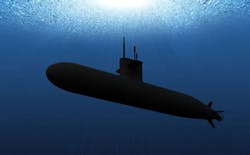General Dynamics to upgrade COTS combat system computers on U.S. and Australian submarines
Officials of the Naval Sea Systems Command in Washington are asking General dynamics to upgrade the computer software and hardware for several different kinds of submarines, including ballistic-missile submarines, cruise-missile submarines, and fast-attack submarines.
The AN/BYG-1 is an open-architecture submarine combat control system for U.S. ballistic missile and fast-attack submarines for analyzing and tracking submarine and surface ship contacts, providing situational awareness, and aiming and firing torpedoes and missiles.
Navy submarine experts are overseeing a project for General Dynamics to upgrade the AN/BYG-1 submarine combat system with commercial off-the-shelf (COTS) computers.
Related: General Dynamics to upgrade submarine weapons control system
The program calls for General Dynamics to replace central processors with COTS computers, and refresh submarine combat system processors with new COTS technologies every one to two years. The AN/BYG-1 system is a counterpart to the Navy's Advanced Rapid COTS Insertion (A-RCI) program that uses COTS computers in submarine sonar signal processing systems.
Submarine crews equipped with the AN/BYG-1 combat control system are able to analyze submarine sensor contact information to track submarine and surface vessels in open-ocean and coastal waters; aim and fire heavyweight torpedoes against submarine and surface ship targets; receive strike warfare orders, plan strike missions and employ Tomahawk land-attack cruise missiles; and receive and synthesize sensor data and external tactical intelligence to produce an integrated tactical picture for situational awareness.
The AN/BYG-1 program includes a combat control system for Virginia-class attack submarines, as well as a replacement upgraded combat control systems for Los Angeles- and Seawolf-class attack submarines and for Ohio-class ballistic-missile and cruise-missile submarines. General Dynamics also is providing AN/BYG-1 system upgrades for Australian Collins-class attack submarines.
The program uses biennial software upgrades called advanced processor builds (APBs) and hardware upgrades called technology insertions (TIs). The Navy began installing the AN/BYG-1 APB-09 system on Virginia-class fast-attack submarines in 2010.
The contract modification announced Thursday calls for General Dynamics to continue upgrading the AN/BYG-1 Tactical Control System computer hardware TI-12 to a TI-14, and integrate APB-13 and APB-15 software aboard the Navy's submarine fleet.
General Dynamics won a $29.7 million contract modification in June 2013 to upgrade TI-10 submarine computer hardware to TI-12 levels, integrate APB-13 software, and begin developing the TI-14 baseline software for Navy submarines.
The AN/BYG-1 modernization program separates development of the tactical control system (TCS) and the weapons control system (WCS) to enable independent yet parallel development and certification, General Dynamics officials say. Each of these systems uses a variety of APB software algorithms developed by industry, government, and academia.
Related: Australian Navy uses Raytheon submarine combat system
The TCS computer hardware portion of BYG-1 integrates sensor inputs to provide a secure common operational picture and improved situational awareness that blends information sonar, electronic support measures, radar, navigation, periscopes, and communications systems. The TCS system architecture allows for rapid COTS insertion to accommodate and integrate additional functionality and sensors.
Previous system enhancements have included improved commanding officer situational awareness by sharing display information across subsystems, and changing some designs to manage and distribute important navigation data.
Some of the latest enhancements under the AN/BYG-1 program have included integration of unmanned aerial vehicle (UAV) command and control (C2), and upgrading high-definition displays.
One of the benefits of rapid COTS technology upgrades to submarine combat systems is the ability for the Navy to learn from real-world experience to make quick improvements. Recent Navy recommendations, for example, were to acquire automation technology to help the operator in areas of high contact density.
Navy officials also have recommended improving operator training, because many of the new features in the APB-07 upgrades that were designed to improve mission performance were not used consistently during testing.
On the current contract modification, General Dynamics will do the work in Fairfax, Va., and should be finished by July 2015. For more information contact General Dynamics Information Systems online at www.gd-ais.com, or Naval Sea Systems Command at www.navsea.navy.mil.
